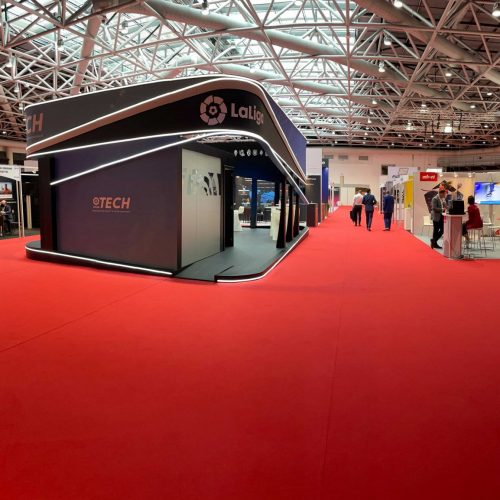The Technological Advances That Have Defined Sports This Decade
by Dakota Murphey
Sports have been a mainstay of life throughout history. From the rise of wrestling more than 153 centuries ago, to the growth of gymnastics back in 500 BCE, sports have continued to grow and grow over the years of human and technological evolution.
Nowadays, technology has advanced to such an extent that it has not only altered the way in which certain sports are completed, it has completely revolutionised it, giving rise to achievements, statistics and experiences that wouldn’t have previously seemed possible.
Even over the past decade, technology has continued to hone and improve how certain sports are carried out – albeit often controversially. From the rise of VAR in football to the introduction of Hawk-Eye in rugby, here are just a few examples of the technological advances seen to have defined sports over the past ten years.
Athletics
Athletics is a discipline which requires incredibly fine detail. Even the smallest of missteps or movements can make a huge difference, so athletes are always on the lookout for ways to refine their art.
Over the past decade, athlete’s clothing has been continually enhanced using technology. Back in 2012, athletic apparel that was able to measure heart rate, respiratory activity, posture, speed and weight distribution was released. Fast-forward to 2016 and upgraded clothing became available, designed to wick sweat away from the body, rather than absorb it.
Perhaps the biggest change in athletics over the past decade though came through the impact of neuroscience. Psychology is absolutely paramount in athletics after all; in order for athletes to perform at their optimum, their brain needs to be working as efficiently as possible.
As such, 2017 saw the introduction of the Halo I headband – a device designed to prepare the brains of athletes for big races. This worked by delivering pulses which, in turn, helped neurons fire together and improve the brain’s efficiency. Two years later, the Halo II was released – an upgraded headband designed to help athletes perform faster by creating new neural circuits in their head.
Football
Ahh, football and technology – where to start.
Unless you’ve been living under a rock for the last few months, you will have likely heard all about how ‘well’ the introduction of VAR is going in the Premier League this season. In essence, there’s still a lot to sort out in order to properly embed the technology into the modern game, but the system does show a lot of promise.
It’s not exactly a new technology either. Back in 2012, VAR was tested for the first time in the Eredivisie. It was then introduced during an international friendly between France and Italy in 2016, and used in the FIFA Club World Cup that followed that year. A year later, the A-League, MLS, Bundesliga and Serie A all started using the system in each of their top-flight leagues, with Spain’s La Liga following suit in 2018. This year also saw VAR make its most public introduction, after being implemented at the 2018 World Cup in Russia.
However, VAR wasn’t the only big technological change of the decade. Back in 2012, the International Football Association Board also amended the ‘Laws of the Game’ to approve another much-needed development: goal-line technology. Since its introduction in the Premier League during the 2013-14 season, it has been a mainstay of the footballing world ever since.
Rugby
Technological advances have been especially prevalent in the world of rugby over the past decade.
Back in 2010, Bradford Bulls became the first team to use GPS tracking to collect data and stats related to player performance. Six years later, specialist sensors started becoming more and more utilised throughout the rugby world, placed under player’s jerseys to track heart rate, field positions, fatigue and potential injuries.
A year prior to that saw the introduction of one of rugby’s biggest ever changes: Hawk-Eye video review technology. This was added to the game to improve the fairness of decisions, using a television match official (TMO) and a selection of rewindable camera angle replays to aid decision making.
Earlier in 2019, virtual reality also started to become utilised by club-level and international rugby teams. Recreating simulated rugby scenarios like line-outs, high balls and first-phase attacks, this technology was designed to improve players’ mental visualisation, reaction times and decision-making skills.
Golf
While on the face of it golf may seem like a simple game that doesn’t need much refining, technology still has a huge role to play.
Back in 2018, the golf manufacturer Calloway joined forces with a team of chemists to produce an upgraded type of golf ball, using Nobel Prize-winning graphene technology at its core. These balls then significantly improved golfers’ game, letting full shots launch higher and aiding their ability to perform spin shots.
The ball upgrades didn’t stop there though. Only a few years later, OnCore patented a new technology for what was known as a ‘genius ball’. This type of golf ball is designed to act as a smart ball, tracking time, distance, roll, carry, ball velocity and using GPS to tell you where it is. It’s not available on the market quite yet, but its introduction promises to be just around the corner.
Other technological advances in golf have come in the form of shoes – to limit the amount of damage done to the turf – and clubs, which are now increasingly being developed by aeronautical engineers.
Golf simulator systems – like the Full Skytrak system – have also become incredibly accurate and more widely used by golfers. Now, even when the weather is bad outside, wannabe golfers can practice their swing and putting performance in the comfort of their own home, obtaining statistics and data in real-time as they go.
Final thoughts…
So, there you have it – some of the biggest technological sporting advances to have been adopted over the past decade.
As we head on into the new era, you may find yourself now wondering which kinds of technologies there are to come: will golfers eventually use hoverboards to get around? Will an athlete finally beat Usain Bolt’s 100m world record? Will VAR ever be universally liked in football?
I guess, as with anything, only time will tell. But, if this past decade is anything to go by, the future certainly looks bright.
About author
You might also like
SPORTEL Monaco 2021: CEO Laurent Puons praises event
The second day of SPORTEL 2021 got underway this morning in Monaco. Following on from yesterday’s masterclasses, Wednesday played host to a number of conference talks from industry-leading professionals. The
SPORTEL 2021: Day One Recap
This year’s prestigious SPORTEL convention kicked off in sunny Monaco today, welcoming a host of familiar faces as well as plenty of new ones. Doors opened at 8:30am with businesses
SPORTEL 2021: Monaco prepares to host prestigious October convention
After a one-year hiatus due to the impact of COVID-19, the world-renowned sports media and tech convention, SPORTEL, returns to host its annual event in Monaco. The conference will take








